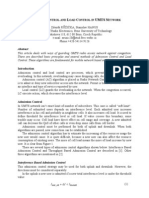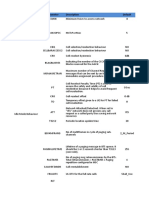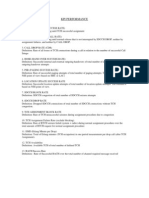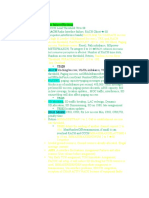0 ratings0% found this document useful (0 votes)
37 viewsBSSPAR - Chapter 08 - Dynamic Hotspot - MO
BSSPAR - Chapter 08 - Dynamic Hotspot - MO
Uploaded by
Samir MezouarThe document discusses the dynamic hotspot algorithm which aims to control load in serving cells and signal quality in adjacent cells. It may reject TCH requests in loaded serving cells if the estimated probability of getting a TCH in an interfered adjacent cell is below a threshold, in order to prevent call drops there. The document explains how the algorithm is activated and how it estimates signal quality and access probabilities.
Copyright:
© All Rights Reserved
Available Formats
Download as PPT, PDF, TXT or read online from Scribd
BSSPAR - Chapter 08 - Dynamic Hotspot - MO
BSSPAR - Chapter 08 - Dynamic Hotspot - MO
Uploaded by
Samir Mezouar0 ratings0% found this document useful (0 votes)
37 views8 pagesThe document discusses the dynamic hotspot algorithm which aims to control load in serving cells and signal quality in adjacent cells. It may reject TCH requests in loaded serving cells if the estimated probability of getting a TCH in an interfered adjacent cell is below a threshold, in order to prevent call drops there. The document explains how the algorithm is activated and how it estimates signal quality and access probabilities.
Original Title
BSSPAR_Chapter 08_Dynamic Hotspot_MO
Copyright
© © All Rights Reserved
Available Formats
PPT, PDF, TXT or read online from Scribd
Share this document
Did you find this document useful?
Is this content inappropriate?
The document discusses the dynamic hotspot algorithm which aims to control load in serving cells and signal quality in adjacent cells. It may reject TCH requests in loaded serving cells if the estimated probability of getting a TCH in an interfered adjacent cell is below a threshold, in order to prevent call drops there. The document explains how the algorithm is activated and how it estimates signal quality and access probabilities.
Copyright:
© All Rights Reserved
Available Formats
Download as PPT, PDF, TXT or read online from Scribd
Download as ppt, pdf, or txt
0 ratings0% found this document useful (0 votes)
37 views8 pagesBSSPAR - Chapter 08 - Dynamic Hotspot - MO
BSSPAR - Chapter 08 - Dynamic Hotspot - MO
Uploaded by
Samir MezouarThe document discusses the dynamic hotspot algorithm which aims to control load in serving cells and signal quality in adjacent cells. It may reject TCH requests in loaded serving cells if the estimated probability of getting a TCH in an interfered adjacent cell is below a threshold, in order to prevent call drops there. The document explains how the algorithm is activated and how it estimates signal quality and access probabilities.
Copyright:
© All Rights Reserved
Available Formats
Download as PPT, PDF, TXT or read online from Scribd
Download as ppt, pdf, or txt
You are on page 1of 8
Dynamic Hotspot
CHAPTER 8
© NOKIA BSSPAR / 10.05.2004
Module Objectives
• Explain the motivation for the dynamic hotspot algorithm
• Give an overview about its applications
• Discuss, by which settings the dynamic hotspot algorithm becomes active
• Explain, how the signal quality of adjacent cells and the probability to get a
TCH in them is estimated
• Demonstrate, how about a TCH request in the serving cell is decided
© NOKIA BSSPAR / 10.05.2004
Dynamic
Hotspot Dynamic Hotspot Idea
Cell A
Cell B
Same frequencies as cell A
Hard blocking: All
TCHs occupied in A
Soft blocking: High load
in A causes high interference in B Calls are
dropped in B
Solution: Load in
A exceeds certain limit -> TCH
request in A rejected, if signal quality in B too
low
© NOKIA BSSPAR / 10.05.2004
Dynamic
Hotspot Dynamic Hotspot Applications
Load control for serving cell + Signal
quality control for interfered adjacent cells
For hopping TRXs For
following procedures
Call set up Inter cell Intra cell
handover handover
Conventional Only regular <->
IUO super reuse TRX
© NOKIA BSSPAR / 10.05.2004
Dynamic Load Dependent TCH Allocation
Hotspot
(Activation)
Thresholds
softBlockingStartReg 0..255 TCHs threshold, if TCH from regular TRX requested
softBlockingStartSup 0..255 TCHs threshold, if TCH from super reuse TRX requested
Number of busy TCHs in serving cell threshold -> feature is active
Default setting -> feature is disabled
© NOKIA BSSPAR / 10.05.2004
Dynamic Load Dependent TCH Allocation
Hotspot
(Adjacent Cell Signal Quality)
Indication of cell as potentially interfered
interferedCell 0..3 0 = not interfered
1 = interfered on regular frequencies
2 = interfered on super reuse frequencies
3 = interfered on both
Estimation of signal quality
TRX -> quality = number of bad uplink/downlink samples / number of all samples * 100 %
Cell -> quality = average over all TRXs
TCH from regular TRX requested -> estimation for interferedCell = 1 or 3
TCH from super reuse TRX requested -> estimation for interferedCell = 2 or 3
© NOKIA BSSPAR / 10.05.2004
Dynamic Load Dependent TCH Allocation
Hotspot
(TCH Access Probability)
Probability to get access to TCH function of signal quality
Theoretical models
Test measurements
Define estimated function as table
Signal quality TCH access probability
Q < GQL (10%) 100 %
GQL (10%) Q < SQL2 (20%) TCP3 (80 %)
SQL2 (20 %) Q < SQL1 (30%) TCP2 (72 %)
SQL1 (30%) Q < BQL (90%) TCP1 (51 %)
BQL (90%) Q 0%
Signal quality thresholds (all 0..100)
GQL = goodQualLimit
SQL2 = sigQualLimit2
SQL1 = sigQualLimit1
BQL = badQualLimit
TCH access probabilities (all 0..100)
TCP3 = tchProbability3
TCP2 = tchProbability2
TCP1 = tchProbability1
© NOKIA BSSPAR / 10.05.2004
Dynamic Load Dependent TCH Allocation
Hotspot
(Decision Process)
At least softBlockingStartReg/Sup
TCHs busy in serving cell
Check which adjacent cells
are interfered according
interferedCell
type of TRX requested
Estimate signal quality of Example
interfered cells
1st cell with Q = 25 % -> P = 72 % 2nd
cell with Q = 35 % -> P = 51 %
Estimate TCH access Total P = 0.72 * 0.51 = 37 % Total P
probability in interfered cells < 50 % -> TCH request rejected
Multiply single probabilities
Total probability < 50 % Otherwise
Reject TCH request Accept TCH request
© NOKIA BSSPAR / 10.05.2004
You might also like
- Introduction to Power System ProtectionFrom EverandIntroduction to Power System ProtectionRating: 4 out of 5 stars4/5 (2)
- Cell Reselection and Handover IntroductionDocument23 pagesCell Reselection and Handover Introductionehsan sohrabi100% (1)
- KPI's AnalysisDocument43 pagesKPI's AnalysisAmin MuhammedNo ratings yet
- LTE - Paramter Introduction and AuditDocument66 pagesLTE - Paramter Introduction and Auditklajdi100% (2)
- Admission Control and Load Control in Umts NetworkDocument4 pagesAdmission Control and Load Control in Umts Networkantony_claret100% (2)
- KPIs AnalysisDocument582 pagesKPIs AnalysisAnonymous oLo6cDDNo ratings yet
- GSM BSS Optimization: Elnaz YaghoubiDocument73 pagesGSM BSS Optimization: Elnaz YaghoubiSaNo ratings yet
- 2G Radio Parameters - HuaweiDocument10 pages2G Radio Parameters - HuaweiSajid HussainNo ratings yet
- Parameter HuaweiDocument100 pagesParameter HuaweironiNo ratings yet
- NSN NetAct Radio Resource MGMTDocument46 pagesNSN NetAct Radio Resource MGMTDmitry Moshkovsky100% (1)
- Data Configuration Manual Huawei 2G BSS Network Planning ParametersDocument35 pagesData Configuration Manual Huawei 2G BSS Network Planning ParametersNeelesh Kumar Marele100% (1)
- Huawei LTE QuestionnaireDocument6 pagesHuawei LTE QuestionnaireJakir HossainNo ratings yet
- RNO Parameter HuaweiDocument28 pagesRNO Parameter HuaweiPraveen KumarNo ratings yet
- MetricDocument5 pagesMetricmosesNo ratings yet
- 1.1 Directed Retry: Figure 1: Directed Retry Procedure Applied When Original Cell CongestedDocument6 pages1.1 Directed Retry: Figure 1: Directed Retry Procedure Applied When Original Cell Congestedst0795No ratings yet
- Parameter HuaweiDocument21 pagesParameter HuaweiFouad TehariNo ratings yet
- TCH Drop Analysis: Change & ObserveDocument8 pagesTCH Drop Analysis: Change & ObserveLenny MajawNo ratings yet
- TCH Drop Analysis: Change & ObserveDocument8 pagesTCH Drop Analysis: Change & ObserveLenny MajawNo ratings yet
- 2G Improvement GuidelineDocument12 pages2G Improvement GuidelineJefri Adi100% (1)
- GSM KPI AnalysisDocument9 pagesGSM KPI Analysislenny majawNo ratings yet
- 2G KPI ImprovementDocument4 pages2G KPI ImprovementdongarsinghNo ratings yet
- BSSPAR - Chapter 03 - Radio - Resource - Management - MODocument26 pagesBSSPAR - Chapter 03 - Radio - Resource - Management - MOSamir Mezouar100% (1)
- V3 (1) .09 ParametersDocument290 pagesV3 (1) .09 ParametersAhmedNo ratings yet
- Huawei TrainingDocument145 pagesHuawei TrainingMuhammad Junaid100% (1)
- GSM Idle Mode BehaviorDocument35 pagesGSM Idle Mode BehaviorsugadoorNo ratings yet
- Tuning 2G OptimDocument11 pagesTuning 2G OptimAshidieqi DqNo ratings yet
- 2G Ericsson Nokia MappingDocument139 pages2G Ericsson Nokia MappingRinaldi AzharNo ratings yet
- TCH & SDCCH Congestion AnalysisDocument4 pagesTCH & SDCCH Congestion AnalysisAbdur RazzaqeNo ratings yet
- Parameters List For GSM (Huawei)Document18 pagesParameters List For GSM (Huawei)mosesNo ratings yet
- Circuit Breaker Failure - SchneiderDocument8 pagesCircuit Breaker Failure - SchneideryosuaNo ratings yet
- GSM Optimization InterviewDocument43 pagesGSM Optimization InterviewAhmed GamalNo ratings yet
- Q: What Is Handover Reversion: All of This Increases Battery Life Considerably When Compared To AnalogDocument4 pagesQ: What Is Handover Reversion: All of This Increases Battery Life Considerably When Compared To Analogamanagarwal16No ratings yet
- Intra Cell HODocument10 pagesIntra Cell HOMostafa Mohammed EladawyNo ratings yet
- Ericsson Nokia MappingDocument90 pagesEricsson Nokia Mappingrjskalu123 123No ratings yet
- 3G BasicDocument6 pages3G BasicMahmudah ZyzyNo ratings yet
- Huawei Dualband Co-BCCH Cell IntroductionDocument18 pagesHuawei Dualband Co-BCCH Cell IntroductionPaul Kabeya100% (2)
- DevopsDocument56 pagesDevopsvidya bvNo ratings yet
- BSC HON Tracker 2019Document45 pagesBSC HON Tracker 2019Lindon ManehetaNo ratings yet
- Rca GSM KpiDocument4 pagesRca GSM KpiAbdul WasaeNo ratings yet
- 2G ParameterDocument40 pages2G ParameterAshwani SharmaNo ratings yet
- KPI Monitoring Training 10302018Document65 pagesKPI Monitoring Training 10302018Luis Merino SulcaNo ratings yet
- Prach PlanningDocument14 pagesPrach PlanningsanNo ratings yet
- Poor CSSRDocument2 pagesPoor CSSRIdowu OjoNo ratings yet
- SD Access Failures/blocking: RACH Radio Interface Failure, RACH GhostDocument34 pagesSD Access Failures/blocking: RACH Radio Interface Failure, RACH GhostAmine AoussatNo ratings yet
- UMTS Cell Selection and ReselectionDocument5 pagesUMTS Cell Selection and ReselectionFaiz Salih MaebedNo ratings yet
- Alarm 7745 For Nokia BTSDocument4 pagesAlarm 7745 For Nokia BTSjigarfm75% (4)
- GSM OptimizationDocument34 pagesGSM OptimizationMuhammad Shahzad Afzal0% (1)
- GSM OptimizationDocument34 pagesGSM OptimizationBAMS2014No ratings yet
- Lecture 3 - Orthogonal Frequency-Division Multiplexing (OFDM)Document31 pagesLecture 3 - Orthogonal Frequency-Division Multiplexing (OFDM)Rafrafin IslamNo ratings yet
- GO - FC3003 - E01 - 0 GSM Optional Feature Package - 42Document42 pagesGO - FC3003 - E01 - 0 GSM Optional Feature Package - 42noumizredhaNo ratings yet
- Patch Clamping: An Introductory Guide to Patch Clamp ElectrophysiologyFrom EverandPatch Clamping: An Introductory Guide to Patch Clamp ElectrophysiologyRating: 4 out of 5 stars4/5 (2)
- Charge-Based MOS Transistor Modeling: The EKV Model for Low-Power and RF IC DesignFrom EverandCharge-Based MOS Transistor Modeling: The EKV Model for Low-Power and RF IC DesignNo ratings yet
- Distribution of Electrical Power: Lecture Notes of Distribution of Electric Power CourseFrom EverandDistribution of Electrical Power: Lecture Notes of Distribution of Electric Power CourseNo ratings yet
- Digital Signal Processing Techniques and Applications in Radar Image ProcessingFrom EverandDigital Signal Processing Techniques and Applications in Radar Image ProcessingNo ratings yet
- Electrical Characterization of Organic Electronic Materials and DevicesFrom EverandElectrical Characterization of Organic Electronic Materials and DevicesNo ratings yet
- 2 - Link Budget, Capacity and FeaturesDocument79 pages2 - Link Budget, Capacity and FeaturesSamir MezouarNo ratings yet
- 7 Configuration ManagementDocument57 pages7 Configuration ManagementSamir Mezouar100% (1)
- 4 - Acceptance Testing RF ThresholdsDocument27 pages4 - Acceptance Testing RF ThresholdsSamir MezouarNo ratings yet
- 1 - Nokia LTE Solution and RoadmapsDocument41 pages1 - Nokia LTE Solution and RoadmapsSamir Mezouar100% (1)
- BSSPAR Chapter 05 Power Control MODocument18 pagesBSSPAR Chapter 05 Power Control MOSamir MezouarNo ratings yet
- BSSPAR Chapter 09 Coverage Enhancement Features MODocument6 pagesBSSPAR Chapter 09 Coverage Enhancement Features MOSamir MezouarNo ratings yet
- BSSPAR - Chapter 04 - Measurement - Processing - MODocument21 pagesBSSPAR - Chapter 04 - Measurement - Processing - MOSamir MezouarNo ratings yet
- BSSPAR - Chapter 01 - Radio - Resource - Administration - MODocument35 pagesBSSPAR - Chapter 01 - Radio - Resource - Administration - MOSamir MezouarNo ratings yet
- BSSPAR - Chapter 02 - Idle - Mode - Operation - WKDocument17 pagesBSSPAR - Chapter 02 - Idle - Mode - Operation - WKSamir MezouarNo ratings yet
- BSSPAR - Chapter 03 - Radio - Resource - Management - MODocument26 pagesBSSPAR - Chapter 03 - Radio - Resource - Management - MOSamir Mezouar100% (1)
- BSSPAR - Chapter 00 - IntroductiontoParameterPlanningDocument9 pagesBSSPAR - Chapter 00 - IntroductiontoParameterPlanningSamir MezouarNo ratings yet
- 6 - Macro-Small Cell Radio Co-ExistenceDocument23 pages6 - Macro-Small Cell Radio Co-ExistenceTharinduNo ratings yet
- Airinterfaces PDFDocument390 pagesAirinterfaces PDFGaurav KukadeNo ratings yet
- Cs2402 Mobile Computing: Unit IiDocument6 pagesCs2402 Mobile Computing: Unit IiparthibaluNo ratings yet
- GSM - Mobility - Important ParamatersDocument12 pagesGSM - Mobility - Important Paramaters271819No ratings yet
- WO - NAST3033 - E01 - 1 UMTS Feature Parameter P127Document127 pagesWO - NAST3033 - E01 - 1 UMTS Feature Parameter P127noumizredhaNo ratings yet
- ZTE FDD LTE Radio Network Optimization Guideline V1 4 1 5Document1 pageZTE FDD LTE Radio Network Optimization Guideline V1 4 1 5Sameer IbraimoNo ratings yet
- Huawei ERAN KPI Reference Summary v1r15c00Document24 pagesHuawei ERAN KPI Reference Summary v1r15c00Believer100% (1)
- Features MappingDocument387 pagesFeatures MappingAleksandar PanicNo ratings yet
- CDMA PrincipleDocument40 pagesCDMA Principlewll scoNo ratings yet
- Inter Frequency HandoverDocument17 pagesInter Frequency Handoverwayan100% (15)
- Huawei RNC Capacity DimensionDocument17 pagesHuawei RNC Capacity DimensionMuhammad Qasim NazirNo ratings yet
- 10-Troubleshooting For Call DropDocument23 pages10-Troubleshooting For Call DropAbdulganiy SaniNo ratings yet
- LTE Optimization GuidelineDocument55 pagesLTE Optimization GuidelineJairo Fabian Basto ParedesNo ratings yet
- UMTS UL&DL Capacity Improvement Solution V1R2.0-LASTDocument65 pagesUMTS UL&DL Capacity Improvement Solution V1R2.0-LASTWaQas AhMad67% (3)
- RF Planning Guide PDFDocument332 pagesRF Planning Guide PDFSrikanth ReddyNo ratings yet
- Introduction To Wireless Communication Sy StemsDocument31 pagesIntroduction To Wireless Communication Sy StemsRutuja VartaleNo ratings yet
- UMTS CoverageDocument36 pagesUMTS CoverageDhananjay ShrivastavNo ratings yet
- LTE KPI Introduction: Huawei Technologies Co., LTDDocument48 pagesLTE KPI Introduction: Huawei Technologies Co., LTDSangwani NyirendaNo ratings yet
- 20.GO - NP01 - E1 - 1 GSM Radio Network Planning Principle-96Document96 pages20.GO - NP01 - E1 - 1 GSM Radio Network Planning Principle-96Tri Nguyen100% (2)
- Cs 1028 Wireless NetworksDocument4 pagesCs 1028 Wireless NetworksBaskyNo ratings yet
- 2.11 Tunnel Coverage PDFDocument5 pages2.11 Tunnel Coverage PDFgagan_555No ratings yet
- Unit 2 Cellular CommunicationDocument115 pagesUnit 2 Cellular Communicationsnehaghodake2110No ratings yet
- Ciphering Procedure in GSM Call FlowDocument3 pagesCiphering Procedure in GSM Call FlowAbdoul Karim MamaniNo ratings yet
- QuestionsDocument108 pagesQuestionsMathews Official100% (1)
- s2 Wireless CommunicationDocument92 pagess2 Wireless CommunicationLtika GharaneNo ratings yet
- Ece 3-2 Cs Syllabus - Ug - r20Document113 pagesEce 3-2 Cs Syllabus - Ug - r20Jøhn WeßłeyNo ratings yet
- GSM Measurement For IRAT HO & Cell ReselectionDocument12 pagesGSM Measurement For IRAT HO & Cell ReselectionAmgadNo ratings yet
- Chapter 2 Revised NewDocument50 pagesChapter 2 Revised NewJoey TribianniNo ratings yet
- GENEX Assistant V300R003C01 Customer Training SlideDocument49 pagesGENEX Assistant V300R003C01 Customer Training SlideNgweno Mzito100% (1)



































































































